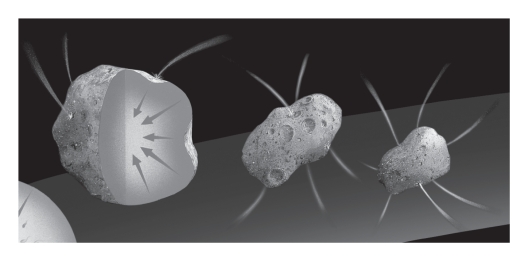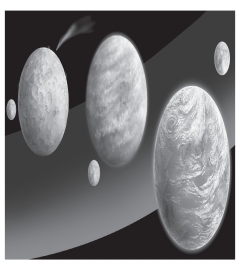A) planet
B) star
C) protoplanet
D) planetesimal
Correct Answer

verified
Correct Answer
verified
Multiple Choice
This is an image of ____________.

A) planetesimals forming protoplanets
B) protoplanets forming planetesimals
C) asteroids forming protoplanets
D) asteroids forming planetesimals
Correct Answer

verified
Correct Answer
verified
Multiple Choice
By far the most common elements in the Universe and in our solar system are ____________.
A) nitrogen and oxygen
B) iron and manganese
C) hydrogen and helium
D) hydrogen and oxygen
Correct Answer

verified
Correct Answer
verified
Multiple Choice
The gas giant,or Jovian,planets are ____________.
A) Mars,Mercury,and Venus
B) Mars,Venus,and Jupiter
C) Jupiter,Saturn,Uranus,and Neptune
D) Mars and Saturn
Correct Answer

verified
Correct Answer
verified
Multiple Choice
The figure below represents the final stage in Earth's formation,which was marked by all of the following EXCEPT ____________.

A) atmosphere formation
B) rains creating the oceans
C) gases being added by passing comets
D) differentiation of the core and mantle
Correct Answer

verified
Correct Answer
verified
Multiple Choice
The circumference of Earth is most nearly ____________.
A) 400 km
B) 4,000 km
C) 40,000 km
D) 4,000,000 km
Correct Answer

verified
Correct Answer
verified
Multiple Choice
Differentiation of the core from the mantle early in Earth's history was possible because the planet was ____________ at the time.
A) very cold
B) very hot
C) very small
D) the only planet in the Solar System
Correct Answer

verified
Correct Answer
verified
Multiple Choice
Chemically,the Moon is quite similar to ____________.
A) sea water
B) Earth's crust
C) Earth's mantle
D) Earth's core
Correct Answer

verified
Correct Answer
verified
Multiple Choice
The inner planets are terrestrial because _________________ .
A) they are made of volatile materials
B) they are made of refractory materials
C) as our Solar System's proto-Sun formed,the inner part of our protoplanetary disk got hotter causing evaporation
D) B and C are both correct.
E) A and C are both correct.
Correct Answer

verified
Correct Answer
verified
Multiple Choice
Which of the following is NOT true about the Kuiper Belt?
A) Gerald Kuiper predicted its existence in 1951.
B) In 1992,astronomers discovered millions of icy objects in this region,which is beyond Neptune.
C) It contains an object called Eris,which is 20% larger than Pluto.
D) Pluto and Eris are now both considered planets.
Correct Answer

verified
Correct Answer
verified
Showing 41 - 50 of 50
Related Exams